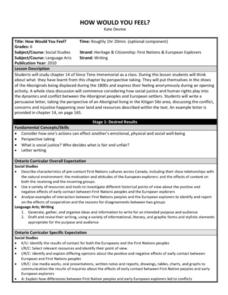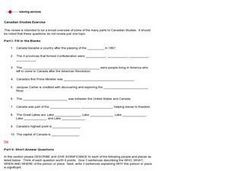Curated OER
How Would You Feel?
Sixth graders put themselves in the shoes of aborigines who were displaced from their homes in the 1800s by Europeans who came in and took their land from them. They discuss the social injustices suffered by these people, and write a...
Curated OER
Parliamentary Structure and Process on " Deck"
Tenth graders design a "deck" of individual slides on Power Point to synthesize, in a graphic organizer, their recently acquired knowledge of different levels of government in Canada.
Curated OER
The European Union and the Canadian Federation: Can they be Compared?
Tenth graders compare the European Union to the Canadian Federation. In this governing bodies lesson, 10th graders compare the structures of the 2 political organizations as they complete the provided handouts and graphic organizers.
Curated OER
Constitution Repatriation Simulation
Students work cooperatively in groups to present the specific needs of an assigned territory to a mock meeting of government officials in an attempt to amend an existing law.
Curated OER
Assembling the Best Possible Cabinet
High schoolers organize a list of qualities that a person must have to become a Prime Minister in Canada, and in groups discuss the quality of choices made by each group. They compare/contrast the list with the current Prime Minister.
Curated OER
How Do You Get to the Hill ?
High schoolers examine how people end up working in any capacity on Parliament Hill. The day to day focus is on the MPs, but students see that the Hill is essentially a small city that requires a small army to keep operating.
Curated OER
Government: War Powers Limitations
Students examine historic examples of authority during wartime. They interpret the Fifth Amendment. They debate the merits of the Patriot Act.
Curated OER
Inside Outside: Habitats and Human Organ Systems
Students examine the way habitats and human organ systems function. In groups, they role play the role of a government group assigned to determine if a settlement can make their home in a specific area. They must discover how humans and...
Curated OER
Treaties- Grade 7
Seventh graders examine treaties pertaining to the Canadian natives. In this Canadian history lesson, 7th graders research and discuss the negotiations that took place between the First Nations cultures and the Canadian government over...
Curated OER
The Real Work is Done in Committee: A Simulation
Students research the Canadian federal legislative process, and identify the main features of local, provincial, and federal governments in Canada. They simulate the process of a bill going through the legislative process.
Curated OER
A Personal Reflection on the Canadian Parliamentary System and Its Delivery to Secondary Students
Students develop a newspaper portfolio of "Canadian Democracy At Work" and find examples of events/decisions/people from media sources to reinforce the concepts of Power and Authority in the Canadian context.
Curated OER
Where Are Our Prime Ministers Found?
Students research the provinces that prime ministers represent, parties that they led, and possible patterns established by the history of politics in Canada.
Curated OER
Statistics Canada
Students practice using graphing tools to make tables, bar charts, scatter graphs, and histograms, using census data. They apply the concept of measures of central tendency, examine the effects of outliers. They also write inferences and...
Curated OER
English Vocabulary Skills: AWL Sublist 8 - Exercise 5b
In this online interactive English vocabulary skills worksheet, students answer 10 matching questions which require them to fill in the blanks in 10 sentences. Students may submit their answers to be scored.
Curated OER
Take the Lead — Get the Lead Out
High schoolers research about the physiological effects of prolonged lead exposure. In this chemistry activity, students investigate the lead content of different paint, soil and water samples. They analyze data trends and share their...
Curated OER
Firsts from Aboriginal Peoples to Pioneers
Young scholars examine Aboriginal people of the Americas. In this history lesson plan, students make connections between their own lives and those of Aboriginal people. Young scholars engage in a 'talking circle' and use storytelling as...
Curated OER
Creating Circles
Students make a circle graph. In this graphing lesson, the teacher conducts a class survey, then demonstrates how to make a pie graph. When students are comfortable with the material, they use a worksheet to create their own graph.
Curated OER
Internet Shopping Business Idea
Students create their own Internet business based on data they find concerning trends in Internet shopping. They discuss advantages and disadvantages to selling specific products and/or services over the Internet.
Curated OER
Canada Day!
In this reading comprehension Canadian history worksheet, students read a multi paragraph passage about the holiday in Canada. Students answer 12 questions.
Curated OER
Distribution of children living at home
Students use E-STAT to examine demographics. In this social demographics lesson, students use statistical data to determine if a particular family is in need of assistance. Students will discuss social and educational policies and...
Curated OER
The Ie Storm 1998: Maps and facts activity
Students investigate the St. Lawrence River Valley, ice Storm of 1998. In this middle school mathematics lesson, students interpret ice storm data from tables and maps. Students write about their own experiences of the ice storm.
Curated OER
Canada Crossword
In this Canada crossword puzzle worksheet, students read 13 clues pertaining to Canada. Students fit their answers in a crossword puzzle, which has no word bank.
Curated OER
Canadian Studies Exercise
In this Canadian history worksheet, 6th graders review many aspects of Canadian studies. Students complete 10 fill in the blank questions, 5 essay questions and 10 true/false questions.
Curated OER
Rent and owner's major payments
Students retrieve and map census data to determine the average rent and owners' payments made throughout Canada. They find out how many people are spending more than 30 percent of their income on housing.

























